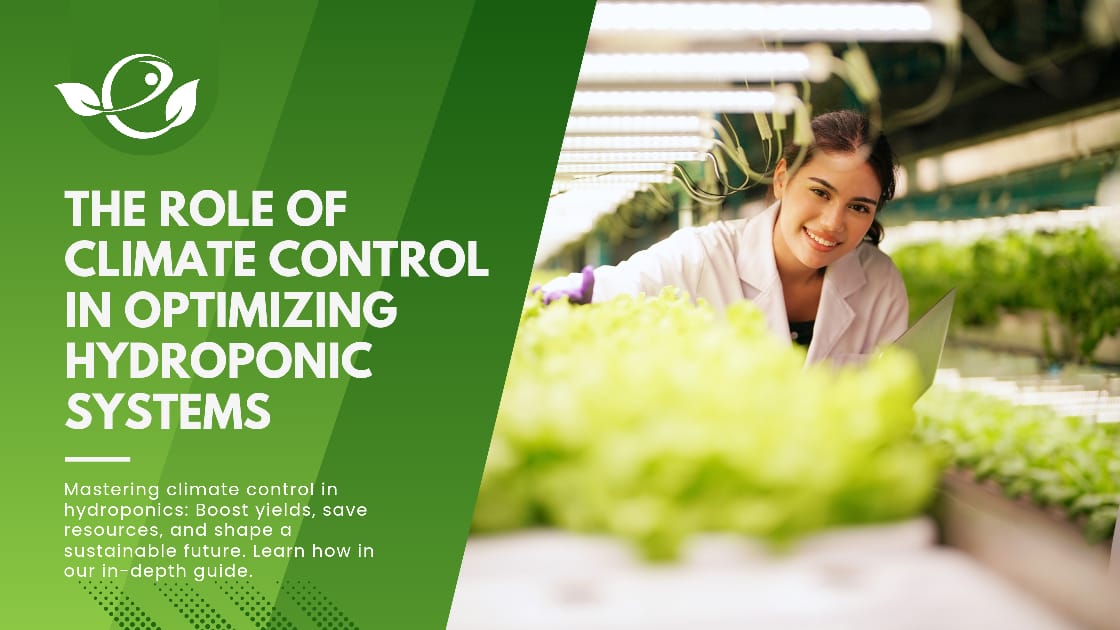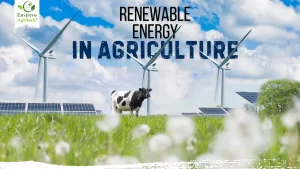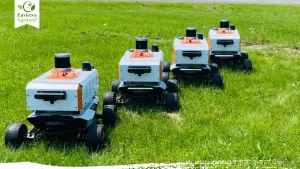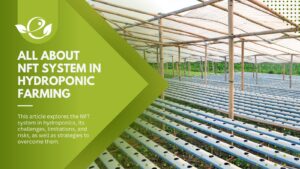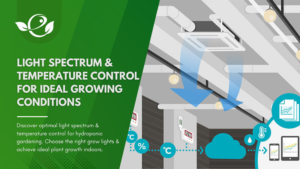Table of Contents
Hydroponics is a soilless cultivation method that offers numerous advantages over traditional farming. With the ability to grow crops in controlled environments, hydroponics maximizes resource utilization, minimizes water usage, and enables year-round production. However, to fully capitalize on its potential, climate control becomes a critical aspect of successful hydroponic systems. In this blog, we will explore the impact of climate on hydroponics, the components of effective climate control systems, how to choose the right equipment, implementation strategies for various setups, maintenance and monitoring techniques, sustainability considerations, success stories, and future trends.
Understanding the Impact of Climate on Hydroponics
The relationship between temperature, humidity, and plant growth
Temperature and humidity are fundamental factors that directly influence plant growth and overall productivity in hydroponic systems. Understanding their impact allows growers to create the ideal environment for different plant varieties:
- Temperature and its effects on plant growth:
- Different crops have specific temperature preferences for optimal growth. For example, lettuce thrives in temperatures between 18°C to 24°C (64°F to 75°F), while tomatoes prefer temperatures around 21°C to 27°C (70°F to 80°F).
- High temperatures can lead to heat stress, causing reduced yields, wilting, and even plant death. On the other hand, low temperatures can slow down growth and affect nutrient absorption.
- Maintaining a stable temperature range supports efficient nutrient uptake, photosynthesis, and root development, contributing to healthier and more robust plants.
- Humidity’s influence on hydroponic crops:
- Humidity levels affect the plant’s ability to transpire, controlling water loss and nutrient uptake. Different stages of plant growth may require varying humidity levels.
- High humidity can lead to issues like mould, fungal diseases, and poor pollination, while low humidity can cause water stress and hinder plant development.
- Striking the right balance between humidity and temperature ensures optimal transpiration rates and nutrient transport, promoting vigorous plant growth.
How light intensity and photoperiod affect hydroponic crops
Light is a primary driver of photosynthesis, and its quality and quantity significantly impact plant growth. In hydroponics, understanding light intensity and photoperiod is essential for successful cultivation:
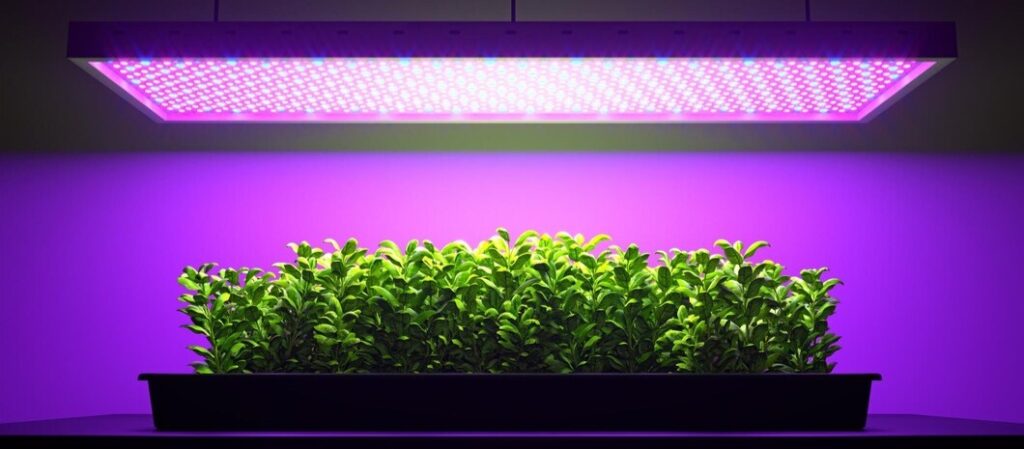
- Light intensity and plant growth:
- Different plant species have specific light intensity requirements. For example, leafy greens thrive in moderate light levels of 200 to 400 µmol/m²/s, while fruiting crops like tomatoes and peppers need higher intensities ranging from 600 to 1000 µmol/m²/s.
- Providing the right light intensity ensures that plants receive sufficient energy for photosynthesis, leading to better biomass accumulation and higher yields.
- Different stages of plant growth require varying light intensities. Insufficient light can lead to elongated and weak stems, while excess light can cause leaf burns.
- Photoperiod:
- The photoperiod refers to the number of hours of light a plant receives within a 24-hour cycle. It influences flowering, fruiting, and other developmental processes.
- Some plants require specific photoperiods to initiate flowering, while others need extended daylight hours for continuous vegetative growth.
- Implementing timers and light control systems enables growers to tailor photoperiods for different growth stages, optimizing plant development.
- Utilizing artificial lighting in hydroponics:
- LED grow lights offer energy-efficient and customizable light spectra to match specific plant needs.
- Supplemental lighting can extend photoperiods in low-light conditions or during the winter.
- Light spectrum control for different growth stages:
- Blue light promotes vegetative growth and leaf development.
- Red light stimulates flowering and fruiting processes.
- Adjusting light spectrum ratios can optimize growth based on plant growth stages.
The significance of CO2 levels in indoor hydroponic setups
In indoor hydroponic environments, CO2 levels can significantly impact plant growth. Proper CO2 management is crucial for maximizing yields and enhancing overall plant health:
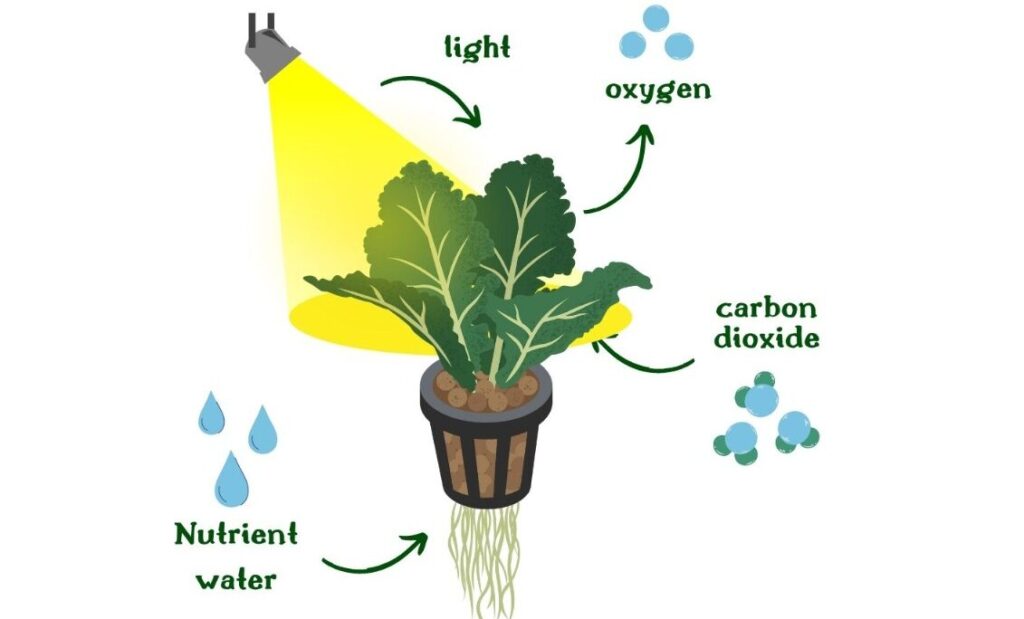
- The role of CO2 in photosynthesis:
- CO2 is a critical component of the photosynthesis process, enabling the plant to produce carbohydrates.
- Adequate CO2 levels promote faster growth and higher yields.
- CO2 depletion in enclosed environments:
- Indoor hydroponic systems often experience CO2 depletion due to limited air circulation.
- Insufficient CO2 levels can slow down photosynthesis, limiting plant growth.
- CO2 supplementation techniques:
- CO2 generators release controlled amounts of CO2 into the growing environment.
- CO2 monitors help maintain optimal CO2 concentrations (around 1000 to 1500 ppm), preventing wastage and ensuring plant health.
- Monitoring and adjusting CO2 levels:
- Regularly measuring CO2 levels is essential to avoid CO2 buildup or depletion.
- Automated CO2 control systems can adjust levels based on plant needs and environmental conditions.
Identifying the ideal climate conditions for different plant varieties
Each plant species has unique climate requirements, and identifying the optimal conditions for specific crops is crucial for successful hydroponic cultivation:
- Research and Reference Guides:
- Botanical references, academic research, and crop-specific guides provide valuable information on the ideal temperature, humidity, light, and CO2 conditions for different plants.
- Growers should consult these resources to create the most suitable environment for their chosen crops.
- Creating microclimates for diverse crops:
- In large hydroponic setups, it may be necessary to create microclimates for different crops.
- Partitioning growing areas and adjusting climate parameters can optimize conditions for each plant variety.
- Tailoring climate-control for growth stages:
- Some plants have varying climate needs during different growth stages (germination, vegetative growth, flowering).
- Adapting climate-control to match growth stages ensures maximum productivity.
- Maintaining detailed records of environmental conditions and corresponding crop performance allows growers to refine their climate-control strategies over time.
The Components of an Effective Climate Control System
A well-designed and efficient climate-control system is essential for maintaining the optimal environment in a hydroponic setup. Each component plays a crucial role in ensuring that plants thrive and achieve their maximum potential:
Temperature regulation: Cooling and heating methods
- Cooling Methods:
- Evaporative Cooling: In hot climates, evaporative cooling systems use water evaporation to reduce the temperature inside the growing area. These systems are energy-efficient and can maintain comfortable temperatures for plants.
- Air Conditioning: HVAC systems with cooling capabilities are effective for maintaining stable temperatures in enclosed environments, providing precise temperature control.
- Heating Methods:
- Electric Heaters: Electric heaters are commonly used for small-scale hydroponic setups and are easy to install and control. They are ideal for maintaining warmth during colder seasons.
- Hot Water Systems: Larger hydroponic operations often use hot water systems connected to radiators or underfloor heating to distribute heat evenly.
- Thermostats and Automated Temperature Controllers:
- Installing thermostats and temperature controllers ensures that the climate control system responds to temperature fluctuations automatically, providing a stable and consistent environment.
- Integrated systems can link temperature control with other climate parameters for comprehensive management.
Humidity management: Strategies to maintain the right levels
- Humidifiers:
- Humidifiers release moisture into the air, increasing humidity levels when necessary.
- Ultrasonic humidifiers: Produce a fine mist, ideal for small to medium-sized grow areas.
- Evaporative humidifiers: Suitable for larger setups, utilizing a fan to disperse moisture.
- These devices help prevent wilting, nutrient imbalances, and stress caused by low humidity levels, especially in arid or indoor environments.
- Dehumidifiers:
- Dehumidifiers remove excess moisture from the air, preventing issues like mold and fungal diseases that thrive in high humidity conditions.
- Refrigerant dehumidifiers: Effective in removing excess moisture from the air.
- Desiccant dehumidifiers: Suitable for colder climates and low humidity conditions.
- They are crucial in maintaining optimal humidity levels, especially during periods of high humidity or in enclosed spaces.
- Relative humidity controller:
- Hygrometers and humidity controllers maintain optimal humidity levels based on crop requirements.
- Maintaining a consistent relative humidity level helps prevent plant stress and diseases.
Light control: Utilizing artificial lighting for optimal growth
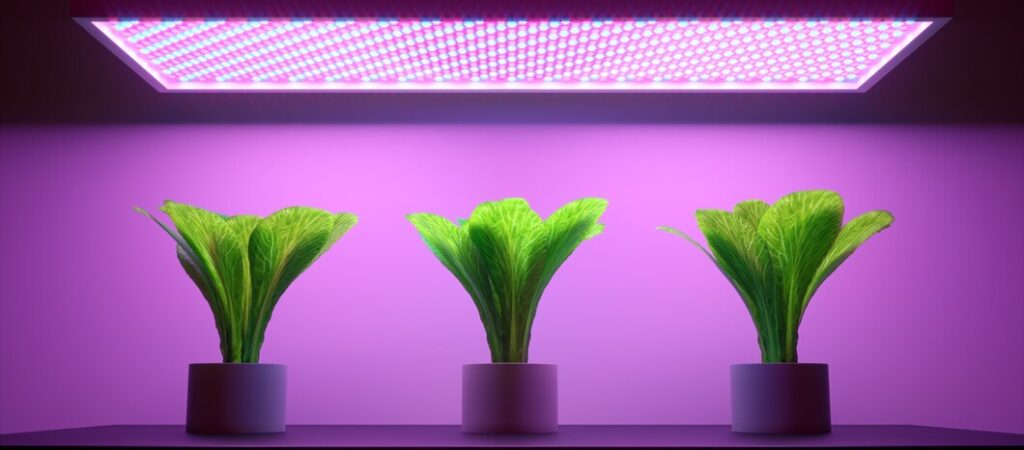
- LED Grow Lights:
- LED grow lights have revolutionized indoor hydroponics due to their energy efficiency and customizable light spectra. They emit specific wavelengths that cater to various growth stages, promoting photosynthesis and plant development.
- Full-spectrum LED lights provide a balanced light distribution that supports both vegetative growth and flowering.
- Timers and Dimmers:
- Timers automate the lighting schedule, ensuring that plants receive the appropriate photoperiod for their growth stage.
- Dimmers allow growers to adjust light intensity, providing precise control over the light environment.
CO2 supplementation techniques for indoor hydroponics
- CO2 Generators:
- CO2 generators release carbon dioxide into the growing area, supplementing naturally occurring CO2 levels to enhance photosynthesis.
- Burner-based generators: Produce CO2 by burning natural gas or propane.
- Bioreactor generators: Utilize microbial fermentation to generate CO2.
- CO2 Monitors:
- Infrared CO2 sensors accurately measure CO2 levels in the growing environment.
- CO2 monitors continuously measure the CO2 levels within the growing environment, providing real-time data to ensure CO2 concentration remains within the optimal range.
- Automated systems adjust CO2 injection based on sensor readings.
Automation and smart technologies in climate control systems
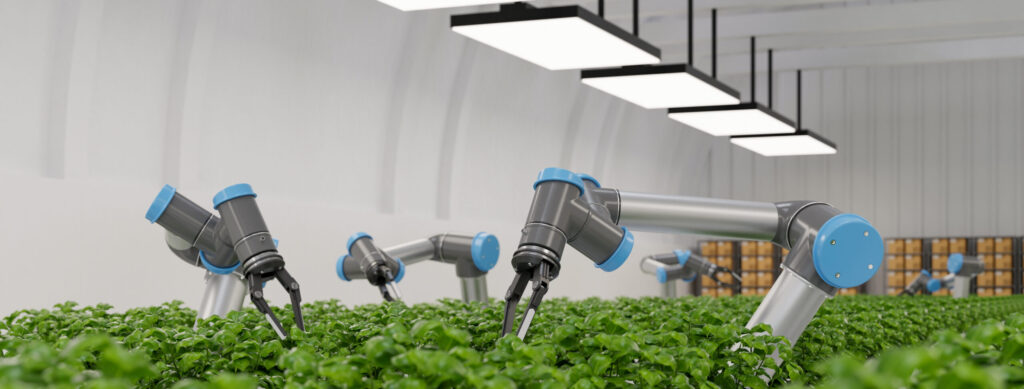
- Sensor integration:
- Temperature, humidity, light, and CO2 sensors collect real-time data for analysis.
- Data-driven decision-making allows for precise and efficient climate control.
- AI and machine learning:
- AI algorithms analyze data patterns to optimize climate conditions for specific plant varieties.
- Machine learning enables climate control systems to adapt and improve over time.
- Remote monitoring and control:
- Mobile apps and cloud-based platforms provide growers with remote access to monitor and adjust climate settings.
- Allows for immediate responses to changing conditions, even when not on-site.
An effective climate control system is a key factor in the success of hydroponic farming. By understanding the impact of climate on plant growth and implementing the right components, growers can create an optimal environment that maximizes yields, minimizes resource wastage, and supports sustainable and efficient hydroponic cultivation.
Choosing the Right Climate Control System for Your Hydroponic Setup
Assessing the size and scale of your hydroponic operation
- Understanding the scope:
- Determine the total area dedicated to hydroponic cultivation, including the number of growing beds or containers.
- Determine the number of plants you intend to grow to estimate the required climate control capacity.
- Consider future expansion plans to ensure the chosen climate control system can accommodate potential growth.
- Calculating the load:
- Assess the heat load generated by the lighting, equipment, and environmental conditions.
- Proper load calculation ensures the climate control system’s capacity meets the actual requirements of the setup.
- Analyzing local climate conditions:
- Evaluate the external climate factors that may impact your hydroponic system (e.g., ambient temperature, humidity, sunlight).
- This analysis helps in selecting the most suitable climate control options for your specific location.
Factors to consider when selecting climate control equipment
- Energy efficiency:
- Opt for equipment with high Energy Efficiency Ratio (EER) or Coefficient of Performance (COP) ratings.
- Energy-efficient systems reduce operational costs and minimize the environmental impact.
- Reliability and maintenance requirements:
- Choose reputable brands and reliable equipment to avoid frequent breakdowns and costly repairs.
- Check maintenance schedules and spare part availability to ensure smooth and uninterrupted operation.
- Integration with existing hydroponic systems:
- Ensure that the chosen climate control system can seamlessly integrate with your current hydroponic setup.
- Compatibility between components simplifies installation and enhances overall efficiency.
- Cost considerations:
- Compare initial investment costs and long-term operational expenses when selecting equipment.
- Balance the upfront cost with the expected benefits and potential savings over time.
Popular climate control system options and their features
- HVAC systems:
- Heating, Ventilation, and Air Conditioning systems provide comprehensive climate control for large-scale hydroponic farms and greenhouses.
- Features:
- Temperature regulation through heating and cooling capabilities.
- Air circulation and ventilation to maintain consistent climate conditions.
- Humidity control options, especially in HVAC systems with integrated dehumidifiers.
- Evaporative cooling:
- Suitable for hot and arid climates, evaporative cooling relies on water evaporation to cool the air.
- Features:
- Lower energy consumption compared to traditional air conditioning.
- Effective in reducing temperatures in greenhouses and other enclosed spaces.
- Requires a constant supply of water for optimal performance.
- Dehumidifiers and humidifiers:
- These devices regulate humidity levels in the growing environment, preventing excessive moisture or dry conditions.
- Features:
- Dehumidifiers remove excess moisture, preventing mould and other humidity-related issues.
- Humidifiers add moisture to the air, supporting plants during dry periods.
- LED grow lights and light spectrum control:
- LED lights offer energy-efficient and customizable lighting solutions for indoor hydroponics.
- Features:
- Various light spectra cater to different growth stages and plant varieties.
- Dimming capabilities to adjust light intensity based on crop requirements.
- Long lifespan and low heat emission, reducing cooling requirements.
- CO2 generators and monitors:
- CO2 supplementation systems ensure plants receive the necessary carbon dioxide for optimal photosynthesis.
- Features:
- CO2 generators provide a controlled release of CO2 to maintain ideal levels.
- CO2 monitors measure CO2 concentration, triggering injection when needed.
- Automated systems maintain a stable CO2 environment without manual intervention.
Implementing Climate Control Strategies in Various Hydroponic Setups
Greenhouse hydroponics: Challenges and solutions

- Temperature control in greenhouses:
- Greenhouses can experience temperature fluctuations due to solar radiation and weather changes.
- Solutions include:
- Installing shade cloths or nettings to reduce excessive sunlight and heat.
- Implementing automated ventilation systems to maintain optimal temperatures.
- Evaporative cooling system can be used to further reduce the temperature.
- Humidity management in greenhouses:
- Greenhouses can experience high humidity, leading to disease outbreaks, fungal issues, and reduced plant growth.
- Solutions include:
- Using exhaust fans to remove excess moisture.
- Employing dehumidifiers during periods of high humidity.
- Light distribution in greenhouses:
- Sunlight may not evenly reach all areas of a greenhouse, affecting plant growth.
- Solutions include:
- Using reflective materials to redirect light to shadowed areas.
- Strategically positioning plants to maximize light exposure.
Indoor vertical farming: Optimizing space and climate
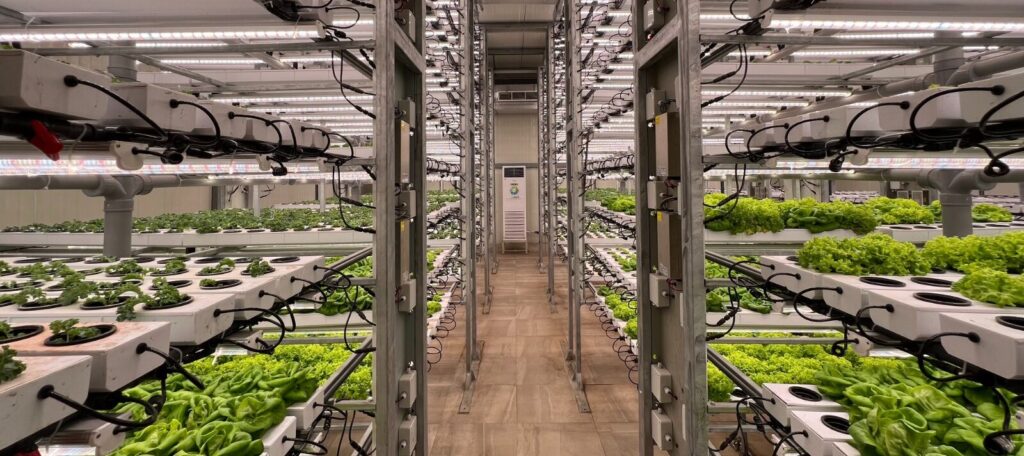
- Controlling temperature in vertical setups:
- Vertical farms can have varying temperature zones due to the vertical arrangement of crops.
- Solutions include:
- Installing fans for air circulation and temperature equalization.
- Utilizing climate control curtains or barriers between levels to manage temperature gradients.
- Lighting strategies for vertical farms:
- Light distribution can be challenging in multi-tiered setups.
- Solutions include:
- Using LED grow lights with adjustable light spectra for specific crop needs.
- Implementing rotating systems to ensure uniform light exposure for all plants.
- Optimizing humidity levels in vertical farms:
- Adequate air circulation and ventilation prevent moisture buildup in stacked growing systems.
- Humidity sensors and controllers ensure balanced moisture levels for all plants.
- Vertical farming automation:
- Implement automated climate control systems to manage the unique challenges of vertical farming efficiently.
- Monitor and adjust climate parameters based on plant growth stages and environmental conditions.
Containerized hydroponics: Climate control for mobility
- Climate control mobility challenges:
- Containerized hydroponic systems need adaptable climate control due to their mobile nature.
- Solutions include:
- Portable climate control units, such as compact HVAC systems, for each container.
- Solar-powered climate control options for off-grid and remote setups.
- Ensuring stability during transportation:
- Containers may experience temperature fluctuations during transportation.
- Solutions include:
- Installing robust climate control systems with secure mounting.
- Implementing remote monitoring to adjust settings during transit.
Home-based hydroponics: DIY approaches to climate management
- Affordable humidity management:
- DIY humidity chambers can be constructed using simple materials like plastic containers and sponges.
- These chambers maintain optimal humidity levels for small-scale home hydroponic setups.
- Customized LED lighting setups:
- Home growers can create DIY LED light systems with adjustable spectrum controls for their specific crop needs.
- Low-cost LED strip lights and controllers are available for hobbyist applications.
- DIY CO2 supplementation techniques:
- Home-based hydroponics can benefit from yeast-based CO2 generators that are easy to assemble and maintain.
- CO2 monitors can help ensure adequate CO2 levels for the plant’s well-being.
- Smartphone-controlled automation:
- Home growers can use smartphone apps to control and monitor climate parameters remotely.
- Automated systems can provide notifications for adjustments and system health updates.
By customizing climate control strategies to fit specific hydroponic setups, growers can ensure optimum conditions for their crops’ health and growth. Considering the scale, location, and crop preferences when selecting equipment, as well as implementing targeted approaches for different setups, allows for efficient and successful hydroponic cultivation across various environments
Maintenance and Monitoring of Climate Control Systems
Importance of regular system maintenance
- Preventing system malfunctions:
- Regular maintenance checks ensure that all climate control components are in proper working condition.
- Detecting and addressing potential issues early prevents unexpected breakdowns during crucial growth periods.
- Ensuring efficient performance:
- Clean filters, fans, and coils allow the system to function optimally, reducing energy consumption and operational costs.
- Well-maintained systems provide consistent and stable climate conditions for healthy plant growth.
- Extending equipment lifespan:
- Proper care and maintenance increase the longevity of climate control equipment, saving on replacement costs over time.
- Timely servicing and parts replacements prevent small problems from escalating into major failures.
Monitoring climate parameters and data analysis
- Sensor-based monitoring:
- Implementing temperature, humidity, light, and CO2 sensors provides real-time data on the growing environment.
- Sensor readings allow growers to track changes, make data-driven decisions, and optimize climate settings.
- Data analysis for optimization:
- Analyzing historical climate data helps identify trends and patterns related to crop performance.
- Using data analysis tools and software, growers can fine-tune climate control strategies for improved yields.
- Automated climate adjustments:
- Integrating sensor data with automated systems enables climate control to respond to changing conditions without manual intervention.
- This enhances system efficiency and frees up growers’ time for other tasks.
Troubleshooting common climate control issues
- Temperature fluctuations:
- Possible causes: HVAC malfunctions, improper insulation, or external climate variations.
- Solutions: Calibrate thermostat settings, seal gaps in the structure, and consider backup climate control measures.
- Humidity imbalances:
- Possible causes: Dehumidifier or humidifier malfunctions, inadequate ventilation, or water leaks.
- Solutions: Regularly check and maintain humidity control devices, ensure proper ventilation, and fix water leaks promptly.
- Lighting irregularities:
- Possible causes: LED failures, incorrect light spectrum settings, or inadequate coverage.
- Solutions: Replace faulty LED bulbs, adjust light spectrum ratios, and optimize light placement for uniform coverage.
Ensuring safety and preventing environmental fluctuations
- Fire safety precautions:
- Avoid placing climate control equipment near flammable materials or electrical hazards.
- Install fire extinguishers and smoke detectors to respond promptly to potential fire incidents.
- Backup power solutions:
- Consider using uninterruptible power supply (UPS) systems to prevent abrupt climate changes during power outages.
- Backup generators can maintain essential climate control functions in case of prolonged power disruptions.
- Environmental monitoring:
- Install environmental sensors to detect factors beyond climate control that may impact plant health, such as air quality and pests.
- Early detection allows for timely interventions and preserves the integrity of the hydroponic system.
Climate Control and Sustainability in Hydroponics
Energy efficiency and its impact on overall sustainability
- Reducing carbon footprint:
- Energy-efficient climate control systems decrease greenhouse gas emissions, contributing to a more sustainable farming model.
- Lower energy consumption aligns with eco-friendly practices and global efforts to combat climate change.
- Renewable energy integration:
- Pairing climate control systems with renewable energy sources further reduces reliance on non-renewable energy.
- Solar panels and wind turbines can power climate control operations, making hydroponics even more sustainable.
Utilizing renewable energy sources for climate control
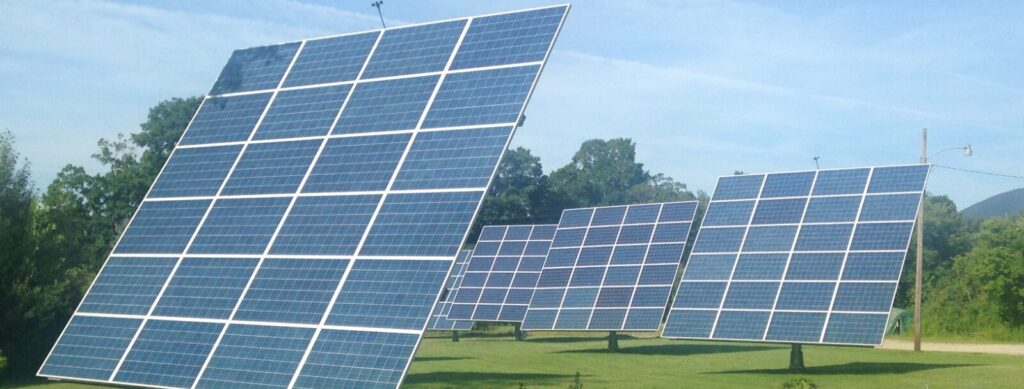
- Solar energy integration:
- Solar panels convert sunlight into electricity, providing a clean and renewable energy source for climate control.
- Installing solar arrays on greenhouse roofs or nearby structures supports sustainable energy production.
- Wind energy utilization:
- Wind turbines harness wind power to generate electricity, suitable for off-grid hydroponic setups.
- Wind energy is an abundant and eco-friendly option for powering climate control systems.
The role of climate control in water conservation
- Reducing water evaporation:
- Efficient climate control systems minimize water loss through evaporation, especially in arid regions.
- Sealed greenhouses and controlled humidity levels help conserve water resources.
- Precision irrigation:
- Integrating climate control data with smart irrigation systems optimizes water usage based on plant needs.
- Automated irrigation prevents water wastage and promotes water-efficient hydroponics.
Reducing the carbon footprint of hydroponic operations
- Sustainable materials and practices:
- Implementing eco-friendly materials for construction and setup reduces the overall carbon footprint.
- Recycling and reusing materials whenever possible also contribute to sustainability.
- Carbon offset initiatives:
- Participating in carbon offset programs or planting trees on-site helps neutralize the carbon emissions produced by the operation.
- Demonstrating commitment to environmental responsibility enhances the farm’s reputation.
Future Trends in Climate Control for Hydroponics
Advancements in climate control technology
- Internet of Things (IoT) integration:
- IoT devices enable remote control, monitoring, and data analysis of climate control systems.
- Automated adjustments based on real-time data lead to more efficient and precise climate management.
- Predictive analytics:
- Machine learning algorithms can predict climate conditions based on historical data and weather forecasts.
- Anticipating changes allows growers to proactively adjust climate control parameters for optimal crop growth.
Integration of AI and machine learning in climate management
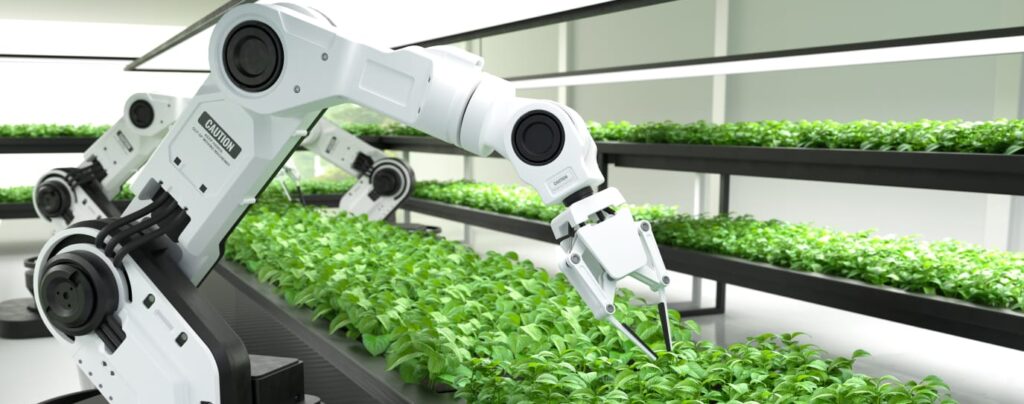
- AI-assisted climate optimization:
- AI algorithms analyze vast datasets from various sensors to fine-tune climate settings for specific plant varieties.
- Continuous learning improves system performance over time.
- Automated decision-making:
- AI-driven climate control systems can autonomously adjust multiple parameters to optimize plant health and yield.
- This reduces the need for manual intervention and enhances operational efficiency.
Climate control’s role in enabling year-round crop production
- Year-round production in controlled environments:
- Advanced climate control technologies facilitate continuous cultivation, regardless of external weather conditions.
- Year-round production ensures a steady supply of fresh and locally grown produce.
- Expanding crop variety and diversity:
- Controlled environments allow growers to experiment with a broader range of plant species, including exotic or rare varieties.
- Diversification enhances food security and market opportunities.
- Maximizing land use efficiency:
- With year-round production, growers can make the most of limited land resources, increasing productivity and sustainability.
As hydroponics continues to evolve, the integration of advanced technology, renewable energy sources, and data-driven decision-making will shape the future of climate control. By embracing sustainable practices and staying at the forefront of technological advancements, hydroponic growers can create a greener, more efficient, and resilient agricultural sector for years to come.
Conclusion
As we conclude this journey through the vital role of climate control in hydroponics, it becomes evident that maintaining optimal environmental conditions is crucial for successful and sustainable crop production. By understanding the relationship between temperature, humidity, light, and CO2 levels, growers can fine-tune their systems to cater to the specific needs of different plant varieties. Choosing the right climate control equipment and implementation strategies for various hydroponic setups ensures efficiency, productivity, and resource conservation. Embracing sustainability and harnessing emerging technologies will drive the future of hydroponics, enabling us to overcome agricultural challenges and secure a bountiful tomorrow.
Thank you for joining us on this educational expedition, and we encourage you to explore the world of hydroponics with the confidence that climate control holds the key to a thriving future in agriculture.
Frequently Asked Questions (FAQ)
1. Can hydroponic systems be used in extreme climates, such as extremely cold or hot regions?
Yes, hydroponic systems can be adapted to extreme climates. In colder regions, growers can employ insulated greenhouses or use heating systems to maintain optimal temperatures for plant growth. In hot regions, shade cloths, evaporative cooling, and proper ventilation can help regulate temperatures and prevent heat stress in plants.
2. How can I prevent pests and diseases in hydroponic setups?
While the article focuses on climate control, pest and disease management are crucial aspects of hydroponic farming. Implementing strict hygiene practices, using sterilized growing media, and maintaining a clean environment can help reduce the risk of pests and diseases. Additionally, introducing beneficial insects or using organic pest control methods can aid in preventing infestations.
3. Are there any hydroponic systems suitable for home gardening in limited spaces?
Yes, there are several hydroponic systems designed specifically for home gardening in limited spaces. Vertical hydroponic systems, hanging gardens, and countertop setups are popular choices for compact living spaces. These systems make use of vertical space efficiently and allow homeowners to grow fresh herbs and leafy greens without the need for a large garden area.
4. Is hydroponics more water-efficient than traditional soil-based farming?
Yes, hydroponics is generally considered more water-efficient than traditional soil-based farming. Hydroponic systems recycle water, reducing overall consumption compared to conventional farming, where water can be lost through runoff and evaporation. However, water usage efficiency also depends on the specific hydroponic setup, climate control measures, and management practices.
5. Can hydroponics be used for growing fruiting crops like tomatoes and peppers?
Absolutely! Hydroponic systems are suitable for growing a wide variety of crops, including fruiting plants like tomatoes, peppers, cucumbers, and strawberries. These plants require adequate light, nutrients, and pollination. Growers can use trellis systems for support, hand-pollinate flowers, and provide the necessary nutrients to ensure successful fruit development.
6. What role does nutrient management play in hydroponic farming?
While nutrient management is not covered in the above article, it is a critical aspect of hydroponic farming. Nutrients are supplied to plants directly through the nutrient solution in hydroponic systems. Proper nutrient management, including the right balance of essential elements, pH levels, and periodic solution changes, is essential for healthy plant growth and optimal yields.
7. Are there any organic hydroponic systems available?
Yes, organic hydroponic systems exist, and growers can use organic-certified nutrient solutions and growing media. Organic hydroponics emphasizes natural and sustainable practices, avoiding the use of synthetic pesticides, herbicides, and chemical fertilizers. Instead, organic growers rely on natural pest control methods and organic-approved nutrient sources.
8. Can hydroponics be combined with aquaculture (aquaponics)?
Yes, hydroponics can be integrated with aquaculture to create aquaponic systems. Aquaponics combines fish farming (aquaculture) with hydroponic plant cultivation. The fish waste provides nutrients for the plants, and the plants, in turn, filter and clean the water for the fish. This symbiotic relationship creates a sustainable and closed-loop ecosystem.
9. What type of training or knowledge is required to start a hydroponic farm?
Starting a hydroponic farm requires a good understanding of hydroponic principles, climate control, nutrient management, and crop-specific requirements. Aspiring growers can gain knowledge through online courses, workshops, or agricultural institutions that offer hydroponics and controlled environment agriculture programs. Practical experience and continuous learning are key to successful hydroponic farming.
10. Are there any potential challenges or risks associated with hydroponic farming?
While hydroponic farming offers numerous benefits, it also presents some challenges and risks. Issues such as system malfunctions, nutrient imbalances, pest outbreaks, and environmental fluctuations can impact crop health and yield. Adequate planning, regular monitoring, and implementing effective pest and disease management strategies are essential to mitigate these risks and ensure a successful hydroponic operation.
